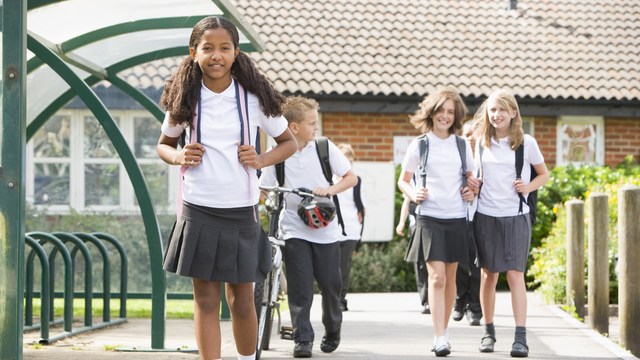 MonkeyBusiness Images/PhotoSpin
MonkeyBusiness Images/PhotoSpin
Back to school means the excitement of picking out a new backpack for many students. But while children and teens concentrate on color and style, parents should also pay attention to size and weight to help their children prevent back pain.
The American Academy of Pediatrics offers these tips for choosing the right back pack:
• Shoulder straps
Make sure the pack has two adjustable shoulder straps that are wide and padded. Narrow straps may dig into the shoulders which can cause pain and reduce blood flow. Avoid packs with one strap that put all the weight on one shoulder or side of the body.
• Padded back
Padding in the back of the pack can protect your student’s back from being poked by sharp objects or book corners.
• Waist strap
Packs with a strap around the waist help support the weight of the pack more evenly which can reduce back pain.
• Light weight
Make sure the pack itself does not add extra weight to the load.
Buying the right backpack is only the first step in preventing back pain. Wearing the pack correctly can also help prevent injury:
• Use both straps
It doesn’t do any good to buy a pack with two shoulder straps if only one strap is used at a time. Remind your student to wear both shoulder straps to even out the load and prevent muscle strain.
• Keep straps tight
Tighten the shoulder straps so the pack stays close to the body and the pack rests about two inches above the waist.
• Keep the pack organized
Backpacks often come with many compartments and pockets. To reduce back strain, make sure the heaviest items are packed closest to the center of the pack. Heavy items on outside pockets may pull the pack off balance.
• Lighten the load
Load up the back and weigh it, then compare it to your child’s body weight. The backpack should weigh no more than 10-20 percent of the child’s weight. So a 50-pound-child’s pack should weigh no more than 10 pounds. A 100-pound child should carry no more than 20 pounds, etc.
• Don’t carry it all
If your student has a locker, encourage him or her to make frequent stops to swap out books instead of carrying everything all day. Some schools also make a second set of books available so one set can stay at school while the other stays at home.
Check with your school’s bookstore or library to find out what is available. Also check whether books are available online for use on a computer at home.
• Lift correctly
Teach your student to lift a heavy pack by bending at the knees.
Rolling backpacks may seem like a good alternative to carry a pack every day. But some schools consider them tripping or walking hazards. Before purchasing a rolling pack, check with your child’s school to make sure these packs are allowed.
Also remember that even though this kind of pack has wheels, your student will still need to carry it up stairs and lift it in and out of vehicles. So rolling packs also need to be as light as possible.
The American Academy of Orthopaedic Surgeons makes these recommendations to help parents ensure that their children’s backpacks are not too heavy:
• Watch your student put the pack on or take it off. If it’s a struggle, the pack is too heavy.
• Make sure your student is aware of warning signs that could mean the pack is too heavy. Encourage him or her to tell you about any back pain or any numbness, tingling or discomfort in the arms or legs which could mean the pack is too heavy.
• Talk to your child’s school about lightening the load and ensuring that students have access to lockers or other places to store heavy books during the day.
Backpacks that are too heavy or that are used incorrectly can hurt muscles and joints, leading to severe neck, back and shoulder pain as well as problems with posture. If your child complains about back pain, take the complaint seriously and work with him or her to find ways to lighten the backpack.
If you have questions or concerns about your child’s pain, talk to your health care provider.
Sources:
HealthyChildren.org. Backpack Safety. Web. August 5, 2014.
http://www.healthychildren.org/English/safety-prevention/at-play/Pages/B...
American Academy of Pediatrics. Back to School Tips. Web. August 5, 2014.
http://www.aap.org/en-us/about-the-aap/aap-press-room/news-features-and-...
American Academy of Orthopaedic Surgeons. Backpack Safety. Web. August 5, 2014.
http://orthoinfo.aaos.org/topic.cfm?topic=a00043
Reviewed August 6, 2014
by Michele Blacksberg RN
Edited by Jody Smith






Add a Comment1 Comments
I believe as technology slowly shapes what we are doing more and more each day, these children will be carrying all their "books" on an iPad or similar. This will reverse the trend of what goes on now, with tremendous textbooks and notebooks being lugged around by our children. The bulk of their backpacks eventually would be from them carrying around their healthy lunches, not heavy books!
Jamie Glick MS, PT
August 6, 2014 - 8:09pmhttp://www.HowToHelpBackPain.com
This Comment